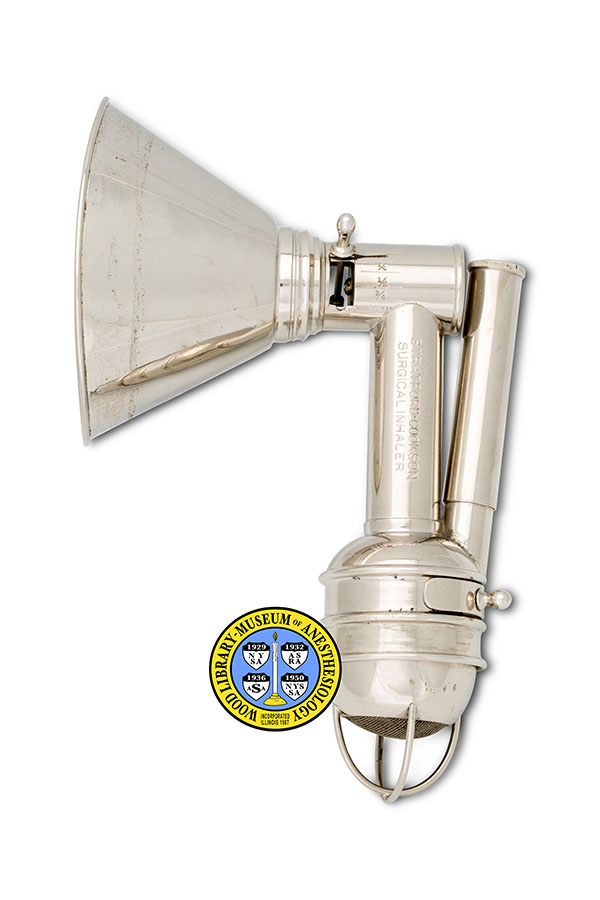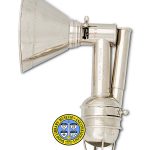Stratford-Cookson Inhaler
The pharmaceutical company Stratford-Cookson introduced this inhaler in 1907. It was intended to be used with either of the company’s branded products, Somnoform or ethyl chloride.
The oval cup at the bottom of the inhaler is enclosed by fine wire mesh. For each procedure, this cup was packed with gauze. The bottom of the cup was then inserted into a rubber re-breathing bag. A glass ampoule of liquid anesthetic was placed in the capsule chamber (the tube that rises from the cup at an angle). Then the tip of the ampoule was broken open by quickly sliding the “guillotine” lever on the side of the cup, and the released liquid was absorbed by the gauze. Any broken glass from the ampoule was also caught in the gauze.
As the patient re-breathed his or her own exhaled air through the bag and mask, carbon dioxide was continually added to the anesthetic vapor. Fresh air could be added by adjusting the lever beside the mask. Compare this to the DeFord Inhaler, introduced five years later.
Catalog Record: Stratford-Cookson Inhaler
Access Key: amvl
Accession No.: 2015-06-05-1
Title: Stratford-Cookson surgical inhaler.
Corporate Author: Stratford-Cookson Company.
Title variation: Alt Title
Title: S-C surgical inhaler.
Publisher: [Philadelphia, Pa.] : Stratford-Cookson, [between 1913-1930].
Physical Descript: 1 inhaler : metals ; 22 x 9.5 x 14.5 cm.
Subject: Inhalers, Anesthesia.
Subject: Somnoform.
Note Type: General
Notes: The early year in the date range for the possible year of manufacture of this
Stratford-Cookson inhaler is based on the year that the Stratford-Cookson
Company advertised that it had purchased E. de Trey & Sons and would be
publishing their “initial advertisement” (1913). The end year is a generous
estimate based on the fact that there are very few references to the
Stratford-Cookson Inhaler after 1930. The date range could change if
documentation or expert opinion indicate that it should be corrected.
Note Type: Citation
Notes: Announcement: E. de Trey & Sons changes hands [advertisement]. Texas Dent J.
1913;31(10):63 [of advertisements]. https://books.google.
com/books?id=BCUMAQAAIAAJ&printsec=frontcover#v=onepage&q&f=false. Accessed
November 25, 2015.
Note Type: Citation
Notes: Items of interest: Somnoform. Cal State J Med. 1915;13(12):493. https://books
google.com/books?id=MZ9CAQAAMAAJ&printsec=frontcover#v=onepage&q&f=false.
Accessed November 25, 2015.
Note Type: Citation
Notes: S-C Surgical Inhaler Complete [booklet]. [Philadelphia]: [Stratford-Cookson
Company]; [1913-1930?]. Company file. Located at : Wood Library Museum of
Anesthesiology, Schaumburg, Illinois. [This publication is not dated.]
Note Type: Citation
Notes: Somnoform [advertisement]. Dent Headlight. 1906;27(4):14 [of advertisements].
https://books.google.
com/books?id=s9saAQAAMAAJ&printsec=frontcover#v=onepage&q&f=false. Accessed
November 25, 2015.
Note Type: Citation
Notes: Somnoform for Analgesia and Surgical Anesthesia. Philadelphia, PA:
Stratford-Cookson Co.; 1919:1-23. Company file. Located at : Wood Library
Museum of Anesthesiology, Schaumburg, Illinois. [The 1919 publication date is
based on the last copyright date printed in this booklet.]
Note Type: Citation
Notes: Somnoform: report of the Council on Pharmacy and Chemistry. In: The
Propaganda for Reform in Proprietary Medicines. Vol 2. Chicago: American
Medical Association; 1922:255. https://books.google.
com/books?id=I5A9AQAAIAAJ&printsec=frontcover#v=onepage&q&f=false. Accessed
November 25, 2015.
Note Type: Physical Description
Notes: One metal inhaler with a metal oronasal mask; The measurements were taken,
and this description is based on a patient’s perspective, i.e. looking into
the mask is the ‘front’ of the inhaler; The rubber lining for the face piece
is no longer with the metal mask; The proximal end of the face mask is ovoid
in shape; It tapers to a cylindrical valve that can be adjusted to allow for
the entry of fresh air; A lever on the valve can be set to “SOMNOFORM” which
closes the valve to fresh air; There are also settings marked “3/4”, “1/2”,
“1/4”, and “AIR”; An approximately 7 cm long breathing tube is attached
perpendicularly to the lower portion of the valve; This breathing tube
measures approximately 2.4 cm in diameter; The following text is stamped into
the right side of the breathing tube: “STRATFORD-COOKSON [new line] SURGICAL
INHALER”; The breathing tube ends at a wider cylindrical cavity that was
meant to hold gauze; A fine wire mesh divides the breathing tube and the
cavity; Just posterior to where the breathing tube enters the cavity is a
narrower tube that acts as a chamber for a Somnoform capsule; This
tube/chamber is approximately 9 cm in height and 1.7 cm in diameter; On the
upper, outer, posterior side of the cavity is a lever that moves back and
forth; According to a brochure published by the company, this lever is called
a “breaking device”; Movement of the outer lever slides a screw, which
extends into the cavity, back and forth; An elevated ring around the
circumference of this cavity is present to help place and hold the opening to
a rubber reservoir, or rebreathing bag, over the end of the cavity; The
bottom portion of the cavity can be detached from the upper portion, and is
cup shaped; A fine wire mesh forms the bottom of the ‘cup’; The gauze would
have sat at the bottom of this cup, over the mesh; The cavity, with the
bottom cup in place measures approximately 6 cm in height and 5.5 cm in
diameter (minus the lever); The outside of the bottom of the cup is protected
by two rounded wires that extend downward and were intended to hold a rubber
reservoir, or rebreathing, bag open and away from the metal mesh; Together,
he height of the chamber and rounded wires measure approximately 8.5 cm in
height; The gauze and rubber rebreathing bag are not with this inhaler; With
the exception of moderate corrosion to mostly the inside of the mask, the
inhaler is in good condition.
Note Type: Reproduction
Notes: Photographed by Mr. Steve Donisch, June 5, 2015.
Note Type: Historical
Notes: The Stratford-Cookson Company introduced their “Surgical Inhaler” sometime
after acquiring the dental supply company E. de Trey & Sons in 1913. Prior to
the acquisition, E. de Trey did market their own inhaler, but the
Stratford-Cookson Inhaler is constructed differently. They both however were
designed specifically for the administration of an inhalation anesthetic
combination called “Somnoform.”
The formula for Somnoform was created in France by Dr. George Rolland, the
director of a dental school in Bordeaux. Formally introduced in 1901, it was
a combination of three different chemicals: ethyl chloride, methyl chloride,
and ethyl bromide. Rolland hoped to create an anesthetic that took effect and
wore off quickly, did not require “cumbersome apparatus” to administer, and
posed less risk than chloroform. Somnoform was very popular in dental
anesthesia for a number of years, but after it proved to be no safer than
chloroform its use waned.
Note Type: Publication
Notes: DeFord WH. Somnoform–continued. In: Lectures on General Anaesthetics in
Dentistry. Pittsburgh, PA: Lee S. Smith & Sons Company; 1912:188-189.
https://ia800302.us.archive.
org/16/items/lecturesongenera1912defo/lecturesongenera1912defo.pdf. Accessed
November 25, 2015. [The Stratford-Cookson bares some similarity to “Stark’s
Inhaler”. This publication contains two illustrations of Stark’s Inhaler.]
Note Type: Exhibition
Notes: Selected for the WLM website (noted November 24, 2015).


